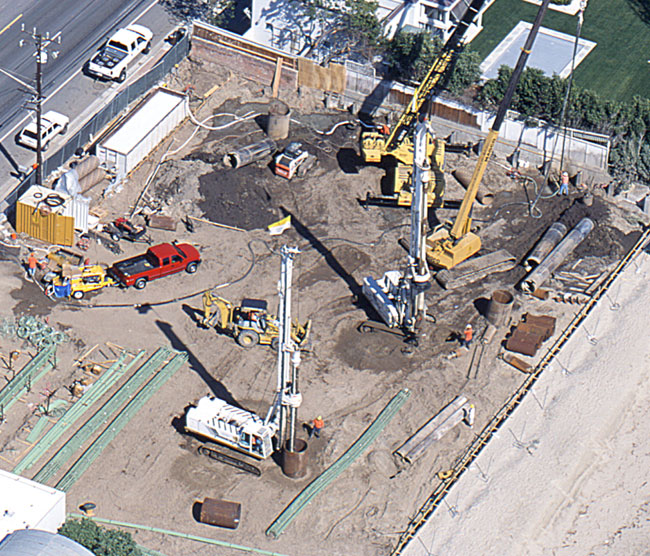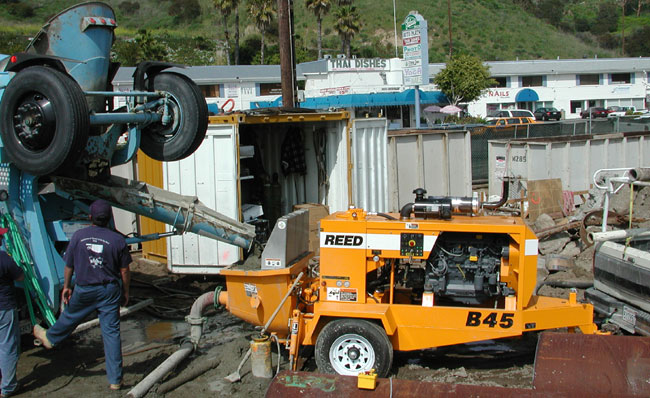One of the beautiful views on earth is the Pacific Ocean, deep and blue, from the beach in Malibu. It would be the perfect spot for home, except that, according to John Pavalonis, “roughly every 10 years, there will be a storm that will wash away all the sand.”
Pavalonis is field supervisor for Magco Drilling, Inc., a specialty contractor best known for caissons, shoring and elevators. Established in 1990, Magco Drilling has built a track record for successful drilling in limited access and low overhead conditions. This past spring, the company pushed its skills to the limit by drilling and filling 81 heavy-duty caissons for a multi-million-dollar home being constructed on the beach in Malibu near Pepperdine University.
The 14,000-square-foot house is the project of Finton Associates of Arcadia, California, which has a specialty in building custom homes. Because the home is being built on beach sand, the entire house —foundation, slab and all— will rest on concrete “stilts” placed by a REED B45 trailer pump.
“BORING” JOB
To construct each stilt, or caisson, Magco drilled holes down from 0-30 ft in solid sand, and then through bedrock to depths of from 90-120 ft.
“The water table is at 10 feet,” explains Mike Maggio, Magco’s owner. “We had to fight water all the way, so we screwed a casing into each hole we drilled to seal the water off.”
According to Maggio, the home has a footprint that is 90 ft from north to south and 180 ft from east to west. That includes a 30-ft by 15-ft swimming pool that is incorporated into the structure.
“The house is being built on sandy soil—beach sand—and requires a ‘starter casing.’ The drill winds a pipe into the ground down to bedrock. The pipe keeps the sand from filling in the hole and prevents the bedrock from caving in,” says Pavalonis.
The drill bored through sand and bedrock. The crew scooped out the rock and sand with a bucket. Then the hole was topped off with drilling mud, which was mixed with a soda ash to raise the pH and keep back the water while holding the hole open.
“BORING” JOB
To construct each stilt, or caisson, Magco drilled holes down from 0-30 ft in solid sand, and then through bedrock to depths of from 90-120 ft.
“The water table is at 10 feet,” explains Mike Maggio, Magco’s owner. “We had to fight water all the way, so we screwed a casing into each hole we drilled to seal the water off.”
According to Maggio, the home has a footprint that is 90 ft from north to south and 180 ft from east to west. That includes a 30-ft by 15-ft swimming pool that is incorporated into the structure.
“The house is being built on sandy soil—beach sand—and requires a ‘starter casing.’ The drill winds a pipe into the ground down to bedrock. The pipe keeps the sand from filling in the hole and prevents the bedrock from caving in,” says Pavalonis.
The drill bored through sand and bedrock. The crew scooped out the rock and sand with a bucket. Then the hole was topped off with drilling mud, which was mixed with a soda ash to raise the pH and keep back the water while holding the hole open.
“We put drilling mud into the casing and mixed it with water to get a slimy consistency,” says Pavalonis. “The hydrostatic pressure of the slime coats the wall and seals it against water seepage. By exerting outward pressure, the slime keeps the hole from caving in.”
HOT MIX
Once the hole is drilled and the sleeve casing is in place and filled with drilling mud, Magco lowers a six-ton cage into the hole with a crane. Then a tremie pipe of 4-in.-diameter steel is lowered through the center of the rebar.
The tremie allows the Magco crew to pump from the bottom up, displacing the drilling mud as they go. As the mud rises to the top, it is removed by a 3-in. drilling trash pump that conveys the drilling mud into a holding tank for future use.
Magco leaves the tremie pipe 4-5-ft deep into the concrete — never above the concrete. Allowing the concrete to “free fall” from the tremie pipe would cause it to segregate.
Around 2,000 yards of concrete, provided by Associated Ready-Mix in Ventura, were placed during the project. The mix was 5,000 psi at 27 days. The 10-sack mix had a 3/8-in. maximum aggregate.
There was little clearance for the concrete around the dense web of reba, says Maggio. The 3/8-in. rock allowed his crew to p the concrete in and around the rebar.
“This was an extremely hot mix, stiffer and quicker reacting, not your typical pea gravel mix,” notes Pavalonis. “The [concrete] was in the truck an hour by the time it got here. I don’t believe a typical pea gravel pump would have been able to handle that mix.”
Maggio says that the admix helped keep the concrete from setting up during the long drive from the batch plant, which was often exacerbated by traffic delays.
Pavalonis adds that, by regulations, they had only one half-hour to unload the truck once it arrived at the jobsite.
The mix was pumped with a REED B45 trailer pump, using from 120-150 ft of 3-in. line to the 4-in. steel tremie. “We ran up to 200 feet of hose to the 120-feet of slickline,” says Maggio.
Magco could have subcontracted the pumping, but Maggio chose to purchase a REED trailer pump, saying “it was more convenient to actually own the pump and to know that it was going to be there when I needed it.” This project has worked so well that Maggio is buying a second REED.
Constructing one caisson required three hours to drill out the hole; a half-hour to place the rebar cage into the hole; and 45 minutes to unload 10 yards of concrete from the truck…with two trucks required per 60-foot caisson. It took approximately three months to finish the 81 caissons.
When the hole was filled with concrete, wires were used to attach the top of the starter casing to the crane, so it could be slipped out of that hole and moved to the next one.
Sand is a problem; the water table is a problem; and seismic activity is another problem.
Concrete was pumped to about 12 feet from the top of the caisson, at which point a metal sleeve was inserted. Then the concrete was pumped to the stop of the sleeve and finished by hand float.
To stabilize the house construction in event of earthquake, the rebar at the opening of the caissons is attached to a grade beam. The rebar is bent into 90-degree hooks at the top, to which the grade beams are attached.
The grade beams are created by placing concrete into rebar-filled trenches that run from caisson to caisson. This creates a concrete gridwork that connects the piles. Concrete placed over the grade beam gridwork will provide the slab for the house.
“We used a DCI concrete additive with water proofing and corrosion inhibiting properties,” says Maggio. “The rebar was all epoxy-coated to prohibit corrosion. Both the admix and the epoxy-coated rebar were very expensive. The rebar alone cost about 150 thousand dollars.”
“This project required us to take things to the limit to make it work,” notes Maggio.
The experience, however, was so positive that Magco is starting a second house down the beach from this first one.
|




